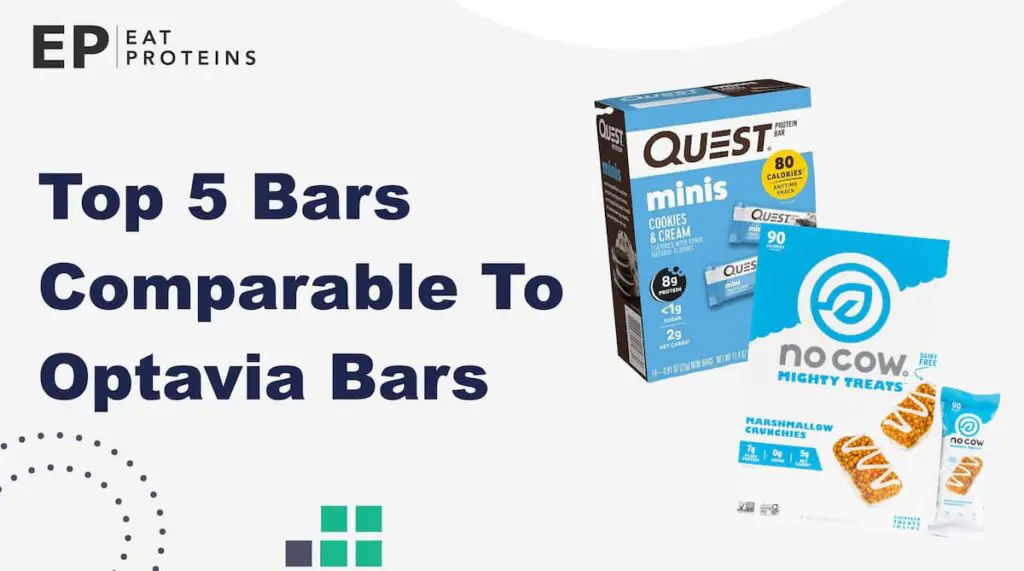
I tested over 20 protein bars similar to Optavia bars from 14 different brands, and to be frank, it wasn’t easy. While many of these bars have high protein content, they also pack too many calories and high sugar levels, making them hardly better than candy bars. After reading dozens of labels, researching ingredients, carefully testing, tasting, and comparing prices, I am finally ready to write a completely unbiased review of my top 5 Optavia bar substitutes.
In our testing, the best soy-free Optavia bar alternative under 100 calories is the Quest Mini Bar at $1.13 per serving and No Cow Mighty Treats at $1.88 per serving. If you’re looking for the best Optavia bar substitute under 150 calories, go for Built Bar at $2.50 per bar.
If a close friend were to ask me what is comparable to Optavia bars, here’s my quick rundown. However, in the following review, you’ll find more details about our top 5 alternatives, along with a buying guide and tips on how to use substitute bars while doing the Optavia diet on your own.
EatProteins.com is a reader-supported platform. Purchases made through our links may earn us a commission at no extra cost to you.
1. Built Bars
Built Bar is one of the best choices for Optavia bar substitutes for weight loss because it’s 50% bigger, has almost twice as much protein, and costs 25% less than Optavia Fuelings at $2.49 per bar. And, in my opinion, Built Bars are way more satisfying than Optavia bars, although they have 30 more calories. I find myself snacking less during the day compared to when I was on Optavia Fuelings. Built bars keep me fuller for hours, whereas after eating Optavia bars I felt I was still hungry. Keep in mind that calories will vary depending on the flavor you choose. Here’s a photo of two Built bars that I bought the other day – Coconut Almond on top and Salted Caramel on the bottom.
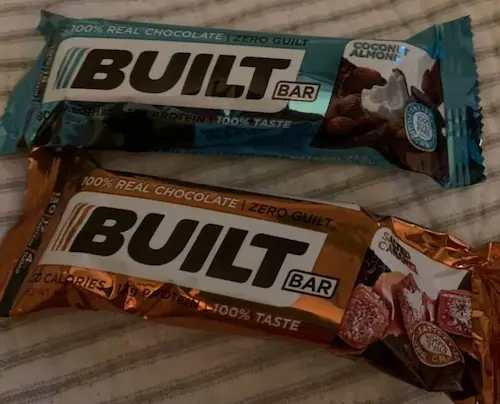
The Built Bar Coconut Almond flavor has 180 calories per serving, whereas the Salted Caramel (on the bottom) has only 130 calories. Other available flavors include Cherry Barcia, Raspberry, Cookies and Cream, Coconut, Mint Brownie, Chocolate, and Peanut Butter. Sure, 130 calories are around 30 more than what you find in Optavia bars, but they also have 17 grams of proteins per serving. And, unlike Optavia bars, Built bars are derived from whey protein isolate, not from soy protein isolate.
In terms of macros, the nutrition stats for Built protein bars include 130 calories, 2.5 grams of total fat, 18 grams of total carbs, 6 grams of fiber, 4 grams of added sugar, and 17 grams of proteins. Built protein bars are priced at $29.99 per box of 12 and offer a taste with a nice balance of savoriness and sweetness, along with a mildly soft and chewy texture, making them a great choice for snacks or meal replacements.
2. No Cow Mighty Treats
No Cow Mighty Treats are like the smaller siblings of Optavia bars, but they’re soy-free and lactose-free. In my opinion, they might not be the kind of snacks that keep you full, but if you’re okay with the 32-gram size of Optavia bars, these are quite similar, and they come at a more budget-friendly price. What I love about them is that they are dairy-free, have 7 grams of plant protein per treat, contain 0 grams of sugar, and only 5 grams of net carbs, making them a guilt-free option at just 90 calories per serving.
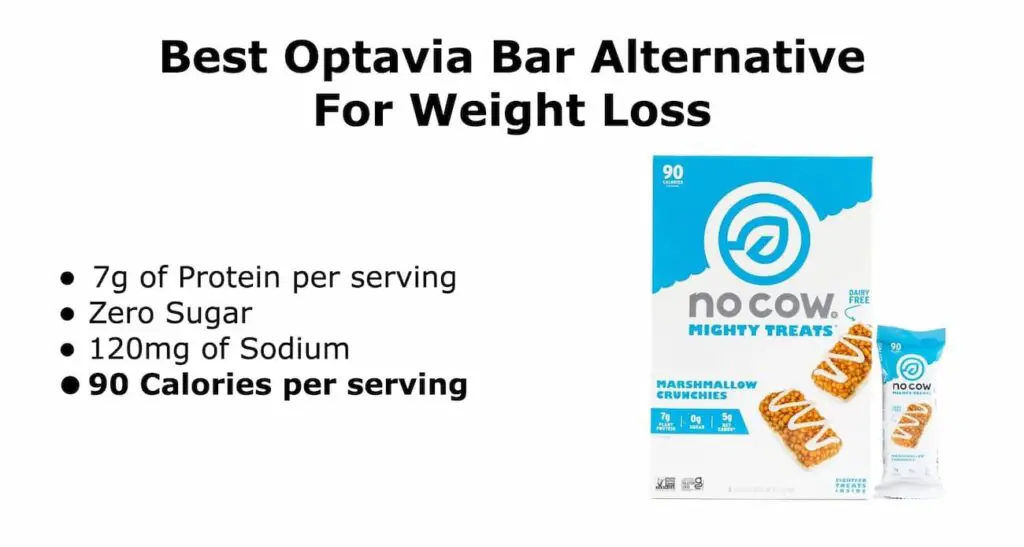
In terms of taste, they’re similar to Optavia’s Creamy Double Peanut Butter Crisp granola bar but without the sugary coating and sticky caramel. However, it’s worth noting that they do contain erythritol and monk fruit as sweeteners, but they don’t leave a horrible aftertaste.
3. Quest Mini Bars
Quest Bars don’t need an introduction, but when choosing Optavia replacement bars, opt for the mini version. Quest Mini Bars are like miniature versions of regular Quest Protein Bars, but they’re 60% smaller and 40% cheaper. If you enjoy the taste of Quest Bars and used to break the bar in half to match the Optavia nutrition facts, well, you don’t have to anymore. At 23 grams per serving, these bars are tiny, even smaller than the aforementioned No Cow Mighty Treats, but they taste way better—everything you’d expect from a mini protein bar: chewy, crunchy, and filling.
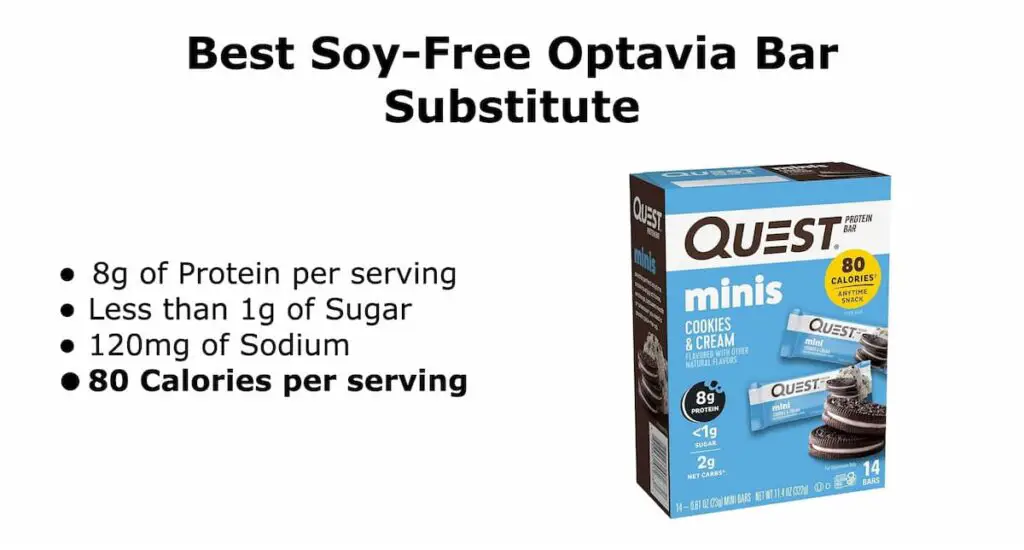
Although they’re 28.1% smaller than Optavia bars, in my opinion, they’re chewy and satisfying, so I don’t feel hungry like after Optavia Fuelings. The only downside I have with Quest Minis is the limited availability of flavors, with only two options: Cookies & Cream and Chocolate Chip Cookie Dough.
4. No Cow Protein Bars
No Cow protein bars are plant-based alternatives to Optavia bars, although they have more calories per serving. These are great options if you’re enjoying the plant-based lifestyle, or you have some stomach issues from eating whey or soy. However, if you’re following the Optimal 5&1 plan, I don’t recommend eating the whole No Cow protein bar at once. No Cow protein bars have 190 calories per serving, 26 grams of total carbs, and 20 grams of protein.
So, to ensure you match the Optavia bar macronutrient profile, break the bar in the middle and eat half of the portion size. (Yes, half of the bar still checks all the boxes.) Half of the No Cow bar has 95 calories, 10 grams of proteins, and no added sugars – equivalent to one Optavia bar, yet seventy percent cheaper. Here’s the photo of my two favorite No Cow bar flavors – raspberry truffle and lemon meringue pie.
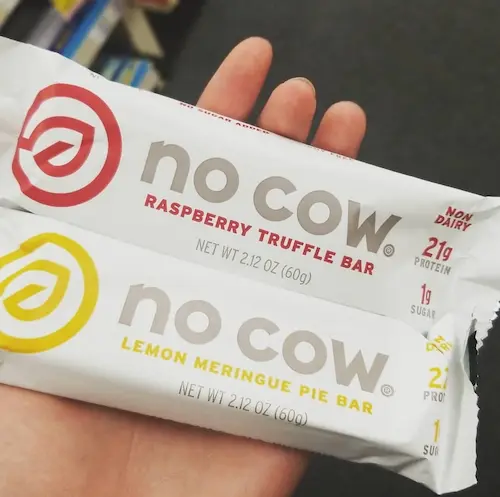
Both of these No Cow protein bars, priced at $2.24 per bar, are rich in pea and rice proteins while being free of soy and dairy. They offer an unexpectedly sweet taste with a subtle earthy aftertaste and have a partially soft texture, thanks to the crunchy cracker pieces, but can be a bit dry overall. They are also available in various flavors, including Chocolate Chip Cookie Dough, Chunky Peanut Butter, Cookies and Cream, Coconut, Birthday Cake, Blueberry Cobbler, and Chocolate Fudge Brownie.
5. Kellogg’s Special K
Kellogg’s Special K is the most budget-friendly Optavia comparable bars, priced at less than $1 per serving. The five-count package retails for $4.29, which is approximately $0.85 per serving, making it the most affordable option comparable to Optavia. To be honest, I’m not a huge fan of Kellogg’s Special K bars becasue of the number of action lawsuits that were filed against this company, mainly due to misleading advertisements. Apart from the complaints, their granola bars are also loaded with sugar and have very few proteins. However, Kellogg’s has recently released new protein snack bars that have 90 calories and 6 grams of protein.
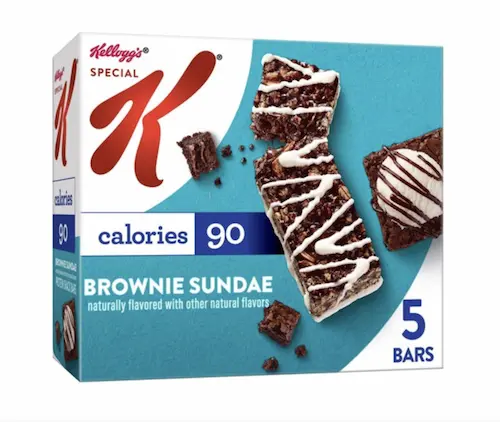
Kellogg’s Special K Brownie Sundae has a rich chocolate flavor with a slightly artificial aftertaste, and, in my opinion, it shares a crunchy and dry texture akin to the Optavia Chocolate Mint Cookie Crisp Bar. Much like Optavia bars, the new Kellogg’s Special K protein snack bars primarily contain soy protein isolate. They offer 90 calories, 2.5 grams of total fat, 13 grams of total carbs, 2 grams of fiber, 6 grams of added sugar, and 6 grams of protein, with Berry Vanilla as an additional flavor choice.
How to Choose Optavia Bar Substitutes?
To choose Optavia bar substitutes for a self-managed Optavia plan, look for bars with similar nutritional profiles, focusing on calorie count, macronutrient balance (proteins, carbohydrates, fats), and ingredient quality.
- Analyze Nutritional Content: Select bars that closely mimic Optavia’s nutritional profile, ideally with at least 6 grams of protein, 2 grams of fiber, and less than 6 grams of added sugar per bar, while keeping calorie count close to Optavia’s range of 110-160 calories.
- Diversify Protein Sources: Opt for bars containing a range of protein sources. Consider animal-based proteins like whey and casein, as well as plant-based options such as pea or hemp protein, to ensure variety in your diet.
- Inspect Ingredient Quality: Focus on bars with minimal processing and limited artificial additives. This aligns with a cleaner eating approach and reduces intake of unnecessary preservatives and sweeteners.
- Balance Cost and Quality: Look for more affordable options than Optavia bars, but ensure that you don’t compromise on nutritional value. Finding a cost-effective substitute can make your DIY Optavia plan more sustainable financially.
- Conduct Taste Tests: Since personal preference is key, try different flavors and brands to find what best suits your palate. This makes the diet more enjoyable and sustainable in the long run.
- Check Reviews and Ratings: Look up customer feedback on potential substitutes to gauge their popularity and effectiveness. User reviews can offer insights into taste, satisfaction, and overall quality.
- Engage with Community: Sign up for Eat Proteins email newsletter and join our private Facebook group for additional support, tips, and shared experiences from others following DIY Optavia diet.
Also, remember that health claims that you read on these lables should be supported by solid scientific evidence. According to a 2005 study by Elaine Turner from University of Florida published in the Nutrition in Clinical Practice Journal, “There are a lot of dietary supplement products that say they will make you healthier, help you manage conditions, and reduce your risk of diseases.”
What protein sources should I look for in bars when doing Optavia on my own?
When choosing protein bars for a DIY Optavia plan, consider a diverse mix of protein sources to cater to different dietary needs and preferences. Include animal-based proteins like whey, casein, and egg whites for high biological value, and plant-based options such as pea, rice, hemp, and soy proteins for those seeking vegan or lactose-free alternatives.
Can you find higher protein alternatives to Optavia bars?
You can find higher protein alternatives to Optavia bars, especially among specialized sports nutrition and health food brands like Quest Nutrition, Now Cow, or Gatorade.
Can homemade bars replicate Optavia bar nutrition?
Yes, homemade bars can replicate Optavia bar nutrition, but it requires a careful selection of ingredients to match the protein, fiber, and calorie content. However, store-bought Optavia copycat bars offer more precision, but you cannot control the ingredients.
Is it feasible to use store-bought bars instead of Optavia’s?
Yes, it’s feasible to use store-bought bars such as Luna Bars, the Zone Bar, or other bars equal to Optavia, as long as they align with the nutritional profile of Optavia’s Fuelings.

I’ve been using the IQBars and they aren’t bad at all. They do have more calories per bar but the plant based ingredients really make up for that. Not to mention that I am not hungry at all.
This is a great review. Thank you for doing the research!